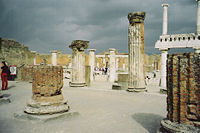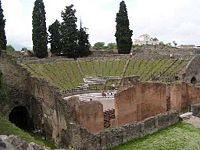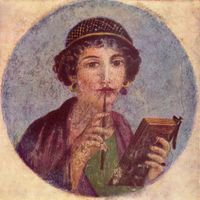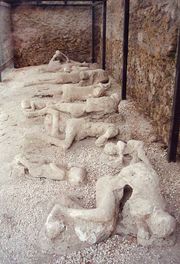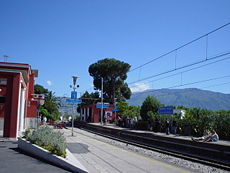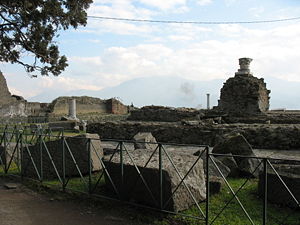Pompeii
2008/9 Schools Wikipedia Selection. Related subjects: Ancient History, Classical History and Mythology
| Archaeological Areas of Pompeii, Herculaneum, and Torre Annunziata* | |
|---|---|
| UNESCO World Heritage Site | |
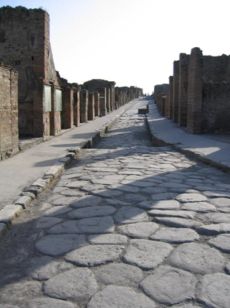 |
|
| Type | Cultural |
| Criteria | iii, iv, v |
| Reference | 829 |
| Region** | Europe and North America |
| Coordinates | Coordinates: |
| Inscription history | |
| Inscription | 1997 (21st Session) |
| * Name as inscribed on World Heritage List. ** Region as classified by UNESCO. |
|
Pompeii is a ruined and partially buried Roman city near modern Naples in the Italian region of Campania, in the territory of the comune of Pompei.
Along with Herculaneum, its sister city, Pompeii was destroyed, and completely buried, during a catastrophic eruption of the volcano Mount Vesuvius spanning two days on 24 August 79 AD.
The volcano collapsed higher roof-lines and buried Pompeii under many meters of ash and pumice, and it was lost for nearly 1700 years before its accidental rediscovery in 1748. Since then, its excavation has provided an extraordinarily detailed insight into the life of a city at the height of the Roman Empire. Today, it is one of the most popular tourist attractions of Italy, with 2,571,725 visitors in 2007, and a UNESCO World Heritage Site.
Location
The ruins of Pompeii are situated at coordinates , near the modern suburban town of Pompei. It stands on a spur formed by a lava flow to the north of the mouth of the Sarno River (known in ancient times as the Sarnus). Today it is some distance inland, but in ancient times it would have been nearer to the coast.
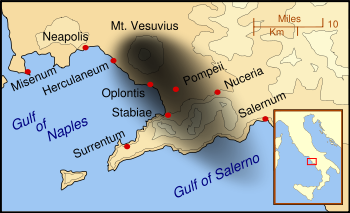
History
Early history
The archaeological digs at the site extend to the street level of the 79 AD volcanic event; deeper digs in older parts of Pompeii and core samples of nearby drillings have exposed layers of jumbled sediment that suggest that the city had suffered from the volcano and other seismic events before then. Three sheets of sediment have been found on top of the lava bedrock that lies below the city and, mixed in with the sediment, archaeologists have found bits of animal bone, pottery shards and plants. Using carbon dating, the oldest layer has been dated to the 8th-6th centuries BC, about the time that the city was founded. The other two layers are separated from the other layers by well-developed soil layers or Roman pavement and were laid in the 4th century BC and 2nd century BC. The theory behind the layers of jumbled sediment is large landslides, perhaps triggered by extended rainfall.
The town was founded around the 7th- 6th century BC by the Osci or Oscans, a people of central Italy, on what was an important crossroad between Cumae, Nola and Stabiae. It had already been used as a safe port by Greek and Phoenician sailors. According to Strabo, Pompeii was also captured by the Etruscans, and in fact recent excavations have shown the presence of Etruscan inscriptions and a 6th century necropolis. Pompeii was captured a first time by the Greek colony of Cumae, allied with Syracuse, between 525 and 474 BC.
In the 5th century BC, the Samnites conquered it (and all the other towns of Campania); the new rulers imposed their architecture and enlarged the town. After the Samnite Wars (4th century), Pompeii was forced to accept the status of socium of Rome, maintaining however linguistic and administrative autonomy. In the 4th century BC it was fortified. Pompeii remained faithful to Rome during the Second Punic War.
Pompeii took part in the war that the towns of Campania initiated against Rome, but in 89 BC it was besieged by Sulla. Although the troops of the Social League, headed by Lucius Cluentius, helped in resisting the Romans, in 80 BC Pompeii was forced to surrender after the conquest of Nola. It became a Roman colony with the name of Colonia Cornelia Veneria Pompeianorum. The town became an important passage for goods that arrived by sea and had to be sent toward Rome or Southern Italy along the nearby Appian Way. Agriculture, oil and wine production were also important.
It was fed with water by a spur from Aqua Augusta (Naples) built circa 20 BC by Agrippa, the main line supplying several other large towns, and finally the naval base at Misenum. The castellum in Pompeii is well preserved, and includes many interesting details of the distribution network and its controls.
1st century
The excavated town offers a snapshot of Roman life in the 1st century, frozen at the moment it was buried on 24 August 79. The Forum, the baths, many houses, and some out-of-town villas like the Villa of the Mysteries remain surprisingly well preserved.
Pompeii was a lively place, and evidence abounds of literally the smallest details of everyday life. For example, on the floor of one of the houses (Sirico's), a famous inscription Salve, lucru (Welcome, money), perhaps humorously intended, shows us a trading company owned by two partners, Sirico and Nummianus (but this could be a nickname, since nummus means coin, money). In other houses, details abound concerning professions and categories, such as for the "laundry" workers (Fullones). Wine jars have been found bearing what is apparently the world's earliest known marketing pun, Vesuvinum (combining Vesuvius and the Latin for wine, vinum). Graffiti carved on the walls shows us real street Latin (Vulgar Latin, a different dialect than the literary or classical Latin). In 89 BC, after the final occupation of the city by Roman General Lucius Cornelius Sulla, Pompeii was finally annexed to the Roman Republic. During this period, Pompeii underwent a vast process of infrastructural development, most of which was built during the Augustan period. Worth noting are an amphitheatre, a Palaestra with a central natatorium or swimming pool, and an aqueduct that provided water for more than 25 street fountains, at least four public baths, and a large number of private houses ( domus) and businesses. The amphitheatre has been cited by modern scholars as a model of sophisticated design particularly in the area of crowd control. The aqueduct branched out through three main pipes from the Castellum Aquae, where the waters were collected before being distributed to the city; although it did much more than distribute the waters, it did so with the prerequisite that in the case of extreme drought, the water supply would first fail to reach the public baths (the least vital service), then private houses and businesses, and when there would be no water flow at all, the system would then at last fail to supply the public fountains (the most vital service) in the streets of Pompeii.
The large number of well-preserved frescoes throw a great light on everyday life and have been a major advance in art history of the ancient world, with the innovation of the Pompeian Styles (First/Second/Third Style). Some aspects of the culture were distinctly erotic, including phallic worship. A large collection of erotic votive objects and frescoes were found at Pompeii. Many were removed and kept until recently in a secret collection at the University of Naples.
At the time of the eruption, the town could have had some 20,000 inhabitants, and was located in an area in which Romans had their holiday villas. Prof. William Abbott explains, "At the time of the eruption, Pompeii had reached its high point in society as many Romans frequently visited Pompeii on vacations." It is the only ancient town of which the whole topographic structure is known precisely as it was, with no later modifications or additions. It was not distributed on a regular plan as we are used to seeing in Roman towns, due to the difficult terrain. But its streets are straight and laid out in a grid, in the purest Roman tradition; they are laid with polygonal stones, and have houses and shops on both sides of the street. It followed its decumanus and its cardo, centered on the forum.
Besides the forum, many other services were found: the Macellum (great food market), the Pistrinum (mill), the Thermopolium (sort of bar that served cold and hot beverages), and cauponae (small restaurants). An amphitheatre and two theatres have been found, along with a palaestra or gymnasium. A hotel (of 1,000 square metres) was found a short distance from the town; it is now nicknamed the "Grand Hotel Murecine".
In 2002 another important discovery at the mouth of the Sarno River revealed that the port also was populated and that people lived in palafittes, within a system of channels that suggested a likeness to Venice to some scientists. These studies are just beginning to produce results.
62-79 AD
The inhabitants of Pompeii, as those of the area today, had long been used to minor quaking (indeed, the writer Pliny the Younger wrote that earth tremors "were not particularly alarming because they are frequent in Campania"), but on 5 February 62, there was a severe temblor which did considerable damage around the bay and particularly to Pompeii. The earthquake, which took place on the afternoon of the 5th, is believed to have registered over 7.5 on the Richter scale. On 5 February in Pompeii there were to be two sacrifices, as it was the anniversary of Augustus being named "Father of the Nation" and also a feast day to honour the guardian spirits of the city. Chaos followed the earthquake. Fires, caused by oil lamps that had fallen during the quake, added to the panic. Nearby cities of Herculaneum and Nuceria were also affected. Temples, houses, bridges, and roads were destroyed. It is believed that almost all buildings in the city of Pompeii were affected. In the days after the earthquake, anarchy ruled the city, where theft and starvation plagued the survivors. In the time between 62 and the eruption in 79, some rebuilding was done, but some of the damage had still not been repaired at the time of the eruption . It is unknown how many people left the city after the earthquake, but a considerable number did indeed leave the devastation behind and move to other cities within the Roman Empire. Those willing to rebuild and take their chances in their beloved city moved back and began the long process of reviving the city.
An important field of current research concerns structures that were being restored at the time of the eruption (presumably damaged during the earthquake of 62). Some of the older, damaged, paintings could have been covered with newer ones, and modern instruments are being used to catch a glimpse of the long hidden frescoes. The probable reason why these structures were still being repaired around 17 years after the earthquake was the increasing frequency of smaller quakes that led up to the eruption.
Vesuvius eruption

By the 1st century, Pompeii was one of a number of towns located around the base of Mount Vesuvius. The area had a substantial population which grew prosperous from the region's renowned agricultural fertility. Many of Pompeii's neighbouring communities, most famously Herculaneum, also suffered damage or destruction during the 79 eruption. By coincidence it was the day after Vulcanalia, the festival of the Roman god of fire.
The people and buildings of Pompeii were covered in up to twelve different layers of soil. Pliny the Younger provides a first-hand account of the eruption of Mount Vesuvius from his position across the Bay of Naples at Misenum, in a version which was written 25 years after the event. The experience must have been etched on his memory given the trauma of the occasion, and the loss of his uncle, Pliny the Elder, with whom he had a close relationship. His uncle lost his life while attempting to rescue stranded victims. As Admiral of the fleet, he had ordered the ships of the Imperial Navy stationed at Misenum to cross the bay to assist evacuation attempts. Volcanologists have recognised the importance of Pliny the Younger's account of the eruption by calling similar events "Plinian".
The eruption was documented by contemporary historians and is universally accepted as having started on August 24th. However the archeological excavations of Pompeii suggest that it was buried 2 months later. People buried in the ash appear to be wearing warmer clothing than the light summer clothes that would be expected in August. The fresh fruit and vegetables in the shops are typical of October, and conversely the summer fruit that would have been typical of August was already being sold in dried, or conserved form. Wine fermenting jars had been sealed over, and this would have happened around the end of October. The coins found in the purse of a woman buried in the Ash include a commemorative coin that should have been minted at the end of September. So far there is no definitive theory as to why there should be such an apparent discrepancy.
Rediscovery
After thick layers of ash covered the two towns, they were abandoned and eventually their names and locations were forgotten. Then Herculaneum was rediscovered in 1738 by workmen working on the foundation of a summer palace for the King of Naples, Charles of Bourbon, and Pompeii in 1748. These towns have since been excavated to reveal many intact buildings and wall paintings. The towns were actually found in 1599 by Domenico Fontana, who was digging a new course for the river Sarno, but it took more than 150 years before a serious campaign was started to unearth them. Charles III took great interest in the findings even after becoming king of Spain.
Karl Weber directed the first real excavations; he was followed in 1764 by military engineer Franscisco la Vega. Franscisco la Vega was succeeded by his brother, Pietro, in 1804. During the French occupation Pietro worked with Christophe Saliceti.
Giuseppe Fiorelli took charge of the excavations in 1860. During early excavations of the site, occasional voids in the ash layer had been found that contained human remains. It was Fiorelli who realised these were spaces left by the decomposed bodies and so devised the technique of injecting plaster into them to perfectly recreate the forms of Vesuvius's victims. What resulted were highly accurate and eerie forms of the doomed Pompeiani who failed to escape, in their last moment of life, with the expression of terror often quite clearly visible ( , , ). This technique is still in use today, with resin now used instead of plaster because it is more durable.
Some have theorized that Fontana found some of the famous erotic frescoes and, due to the strict modesty prevalent during his time, reburied them in an attempt at archaeological censorship. This view is bolstered by reports of later excavators who felt that sites they were working on had already been visited and reburied. Even many recovered household items had a sexual theme. The ubiquity of such imagery and items indicates that the sexual mores of the ancient Roman culture of the time were much more liberal than most present-day cultures, although much of what might seem to us to be erotic imagery (eg oversized phalluses) was in fact fertility-imagery. This clash of cultures led to an unknown number of discoveries being hidden away again. A wall fresco which depicted Priapus, the ancient god of sex and fertility, with his extremely enlarged penis, was covered with plaster, even the older reproduction below was locked away "out of prudishness" and only opened on request) and only rediscovered in 1998 due to rainfall .
In 1819, when King Francis I of Naples visited the Pompeii exhibition at the National Museum with his wife and daughter, he was so embarrassed by the erotic artwork that he decided to have it locked away in a secret cabinet, accessible only to "people of mature age and respected morals". Re-opened, closed, re-opened again and then closed again for nearly 100 years, it was briefly made accessible again at the end of the 1960s (the time of the sexual revolution) and was finally re-opened for viewing in 2000. Minors are still only allowed entry to the once secret cabinet in the presence of a guardian or with written permission.
A large number of artifacts come from Pompeii are preserved in the Naples National Archaeological Museum.
Pompeii today
Pompeii has become a popular tourist destination for centuries (it was on the Grand Tour); with approximately 2.5 million visitors a year, it is the most popular tourist attraction in Italy. It is now part of a larger Vesuvius National Park and was declared a World Heritage Site by UNESCO in 1997. To combat problems associated with tourism, the governing body for Pompeii, the Soprintendenza Archaeological di Pompei have begun issuing new tickets that allow for tourists to also visit cities such as Herculaneum and Stabiae as well as the Villa Poppaea, to encourage visitors to see these sites and reduce pressure on Pompeii.
Pompeii is also a driving force behind the economy of the nearby town of Pompei. Many residents are employed in the tourism and hospitality business, serving as taxi or bus drivers, waiters or hotel operators.
The ruins can be reached by simply walking from the modern town to the various entrances, there are adequate car parks and the entrances are also accessible to tourists through the train line to the modern town, or else a private train line, the Circumvesuviana, that runs directly to the ancient site.
Excavations in the site have generally ceased due to the moratorium imposed by the superintendent of the site, Professor Pietro Giovanni Guzzo. Additionally, the site is generally less accessible to tourists, with less than a third of all buildings open in the 1960s being available for public viewing today. Nevertheless, the sections of the ancient city open to the public are extensive, and tourists can spend many days exploring the whole site.
In popular culture
Pompeii has been in pop culture significantly since rediscovery. Book I of the Cambridge Latin Course teaches Latin while telling the story of a Pompeii resident, Lucius Caecilius Iucundus, from the reign of Nero to that of Vespasian. The book ends when Mount Vesuvius erupts, where Caecilius and his household are killed. The books have a cult following and students have been known to go to Pompeii just to track down Caecilius's house. It was the setting for the British comedy television series Up Pompeii!, the movie of the series and second episode of the fourth series of revived BBC drama series Doctor Who, named " The Fires of Pompeii".
Issues of conservation
The objects buried beneath Pompeii were remarkably well-preserved for almost two thousand years. The lack of air and moisture allowed for the objects to remain underground with little to no deterioration, which meant that, once excavated, the site had a wealth of sources and evidence for analysis, giving remarkable detail into the lives of the Pompeiians. Unfortunately, once exposed, Pompeii has been subject to both natural and man-made forces which have rapidly increased their rate of deterioration.
Weathering, erosion, light exposure, water damage, poor methods of excavation and reconstruction, introduced plants and animals, tourism, vandalism and theft have all damaged the site in some way. Two-thirds of the city has been excavated, but the remnants of the city are rapidly deteriorating. The concern for conservation has continually troubled archaeologists. Today, funding is mostly directed into conservation of the site; however, due to the expanse of Pompeii and the scale of the problems, this is inadequate in halting the slow decay of the materials. An estimated US$335 million is needed for all necessary work on Pompeii.
